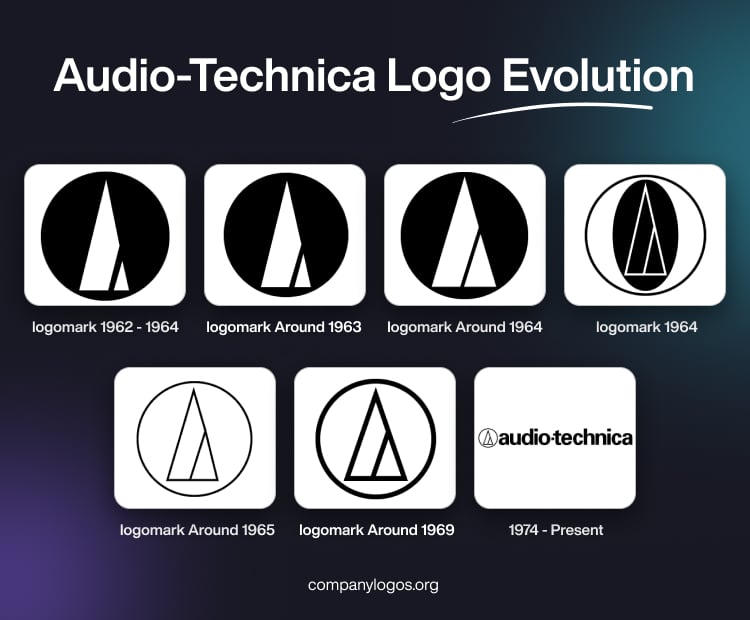
Audio-Technica is a globally recognised Japanese company that specialises in producing high-performance audio equipment. Founded in Tokyo in 1962 by Hideo Matsushita, the company began with phonograph cartridges and quickly expanded into microphones, headphones, wireless systems, and professional audio gear.
Audio-Technica serves both consumers and professionals, with products ranging from studio-grade microphones and monitor headphones to turntables and wireless solutions. Its logo has remained consistent throughout the existence of the company. The article delves into the various logo iterations of the company, among other details.
The Genesis of the Audio-Technica Logo (1962 – 1964)
The original logo of Audio-Technica traces its origins to the founding of the company in 1962. Often referred to as “the meatball”, the logo comprised a circle representing the vinyl phonograph record, while the two uneven triangles represented the phonographic needle as well as the letter “A” for the brand name “Audio-Technica”. Importantly, the space between the circle and the points of the triangle is quite narrow, which highlights the degree of precision engineering used by the company.

(Around 1963)
The first logo change comprising only the logomark was subtle, as the original design was retained in its entirety. It was only the size of the white triangles that was tweaked a little.

(Around 1964)
Around 1964, the size of the smaller triangle was increased in proportion to the bigger one.

(1964)
In the 1964 iteration, the black circle was made smaller into an oval shape behind the white-lined triangles. All the above elements were further encircled with a black outline.

(Around 1965)
In the 1965 logo iteration, the black oval was removed altogether, leaving only the outlines of the triangles and the outside circle.

(Around 1969)
The logo around this period had the lines of the emblem comprising the circle and the twin triangles turned bold and thicker.

(1974 – Present)
The current logo traces its introduction to 1974, when the graphical emblem was made thinner. The brand name in bold lowercase was written alongside using a Univers Next Pro Regular typeface.

The Elements of the Audio-Technica Logo
Symbol
The graphical emblem in the Audio-Technica logo is made up of a circle denoting a vinyl record, two inner triangles denoting a groove and stylus, and negative space
Font
The wordmark in the Audio-Technica logo is executed using a clean, lowercase, sans-serif Univers Next Pro Regular typeface.
Colour
The Audio-Technica logo is designed using black, grey, and white colours to convey elegance and clarity.
The History of Audio-Technica
Audio-Technica was founded in Tokyo, Japan, in 1962 by Hideo Matsushita. Initially, the company specialised in manufacturing phonograph cartridges, with its first products being the AT-1 and AT-3 MM stereo cartridges. These quickly gained recognition in Japan’s hi-fi community for their performance and affordability. The early focus of the company on cartridges tied it directly to the vinyl boom of the 1960s. Further, its expertise in transducer technology (the conversion of mechanical vibrations into sound) became the foundation for its future product innovations.
By the 1970s, Audio-Technica expanded internationally by opening offices in the U.S. and Europe. During this time, the company diversified into headphones and microphones. It laid the groundwork for its reputation as a comprehensive audio solutions provider.
During the 1980s, Audio-Technica continued to grow as vinyl’s dominance declined but demand for headphones and microphones rose. The brand became well known among musicians, broadcasters, and recording engineers for delivering professional-grade audio gear at competitive prices.
A major milestone came in 1996, when Audio-Technica introduced the now-legendary ATH-M50 studio monitor headphones. It was designed for professional monitoring, and it eventually became a global reference for both professionals and casual listeners. It spawned the entire M-Series line that remains iconic today.
In parallel, the company developed condenser microphones such as the AT4033 and AT4050, which became popular with studios worldwide. These mics offered professional-quality sound at more accessible prices compared to established European brands and gave Audio-Technica an edge in the recording industry.
By the 2000s, Audio-Technica had established its reputation in studios as well as in broadcast, live performance, and consumer audio. The microphones produced by the company were used at major events such as the Summer and Winter Olympic Games. For instance, it started in the 1996 Atlanta Games and continued as an official supplier for numerous Olympics thereafter. Audio-Technica also embraced the digital age by developing USB microphones (like the AT2020USB). It catered to podcasters, streamers, and home recording enthusiasts. This move made the brand accessible to a new generation of creators.
In the 2010s, Audio-Technica expanded its consumer lineup with wireless headphones, Bluetooth earphones, and true wireless earbuds. At the same time, it continued to refine its professional lines. Models like the ATH-M50x (a successor to the M50) and the ATH-R70x open-back reference headphones ensured the dominance of Audio-Technica remains in the studio and audiophile markets. The brand also maintained its presence on the world stage. For instance, Audio-Technica microphones have been a fixture at events like the GRAMMY Awards, presidential debates, and large-scale sports broadcasts.
In recent years, Audio-Technica has leaned into both heritage and innovation. So, while it celebrates its vinyl origins with high-quality turntables, it embraces cutting-edge wireless technologies. Its ability to balance tradition and modernity has ensured its ongoing relevance in a crowded audio market.
Interesting Facts About Audio-Technica
- Audio-Technica was founded in 1962 in Tokyo by Hideo Matsushita, and it began its operations by manufacturing phonograph cartridges. Its first two models, the AT-1 and AT-3, laid the foundation for its reputation in precision transducer technology.
- The company’s circular logo, often nicknamed the “meatball” by fans and employees, symbolises a phonograph record and stylus groove. It has remained essentially unchanged since the 1960s.
- Since the 1996 Atlanta Olympic Games, Audio-Technica microphones have been used as official broadcast equipment at multiple Olympic Games. It is a testament to their reliability and sound quality on the world’s biggest stage.
- Released in 2007, the ATH-M50 headphones (and later the ATH-M50x) became one of the most popular studio monitors worldwide. They’re praised by professionals and casual listeners alike.
- In the 1990s, Audio-Technica shook up the industry by releasing high-quality condenser microphones (like the AT4033 and AT4050) at more accessible prices. It provided home studios with professional sound without premium European costs.
- Beyond consumer headphones and mics, Audio-Technica makes phonograph cartridges, wireless systems, conference microphones, DJ gear, and turntables. This diverse portfolio reflects the company’s philosophy of serving both professionals and enthusiasts.
- Although Japanese in origin, Audio-Technica operates globally. It has subsidiaries in the U.S., Europe, Singapore, and other regions, and its products are sold in over 100 countries.
- Audio-Technica was among the first major companies to release USB condenser microphones (like the AT2020USB), which became extremely popular with podcasters, streamers, and home recording creators.
- Audio-Technica microphones have been widely used at U.S. presidential debates, the GRAMMY Awards, and countless live events. These highlight the brand’s trustworthiness in critical professional settings.
- While Audio-Technica embraces cutting-edge wireless and digital audio technology, it also honours its vinyl heritage by continuing to produce high-quality turntables and cartridges.
Finally
The Audio-Technica logo is an example of design consistency that has stood the test of time. Since its introduction in the 1960s, the circular emblem, representing a phonograph record, the groove, and the stylus, has remained at the heart of the company’s visual identity.
Unlike many brands that undergo frequent redesigns, Audio-Technica has chosen to refine rather than reinvent without straying from the original concept. The Audio-Technica logo is a visual bridge between past and present. It links the company’s vinyl-era origins to its role at the forefront of today’s audio innovation.